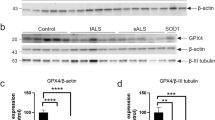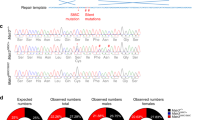Abstract
The mechanisms underlying disease manifestations in neurodegeneration remain unclear, but their understanding is critical to devising effective therapies. We carry out a longitudinal analysis in vivo of identified motoneurons selectively vulnerable (VUL) or resistant (RES) to motoneuron disease (amyotrophic lateral sclerosis, ALS) and show that subtype-selective endoplasmic reticulum (ER) stress responses influence disease manifestations. VUL motoneurons were selectively prone to ER stress and showed gradually upregulated ER stress markers from birth on in three mouse models of familial ALS (FALS). 25–30 days before the earliest denervations, ubiquitin signals increased in both VUL and RES motoneurons, but an unfolded protein response coupled with microglial activation was initiated selectively in VUL motoneurons. This transition was followed by selective axonal degeneration and spreading stress. The ER stress–protective agent salubrinal attenuated disease manifestations and delayed progression, whereas chronic enhancement of ER stress promoted disease. Thus, whereas all motoneurons are preferentially affected in ALS, ER stress responses in specific motoneuron subtypes influence the progressive manifestations of weakening and paralysis.
This is a preview of subscription content, access via your institution
Access options
Subscribe to this journal
Receive 12 print issues and online access
$209.00 per year
only $17.42 per issue
Buy this article
- Purchase on Springer Link
- Instant access to full article PDF
Prices may be subject to local taxes which are calculated during checkout







Similar content being viewed by others
References
Boillee, S., Vande Velde, C. & Cleveland, D.W. ALS: a disease of motor neurons and their nonneuronal neighbors. Neuron 52, 39–59 (2006).
Matsumoto, G., Stojanovic, A., Holmberg, C.I., Kim, S. & Morimoto, R.I. Structural properties and neuronal toxicity of amyotrophic lateral sclerosis-associated Cu/Zn superoxide dismutase 1 aggregates. J. Cell Biol. 171, 75–85 (2005).
De Vos, K.J. et al. Familial amyotrophic lateral sclerosis-linked SOD1 mutants perturb fast axonal transport to reduce axonal mitochondria content. Hum. Mol. Genet. 16, 2720–2728 (2007).
Gurney, M.E. et al. Motor neuron degeneration in mice that express a human Cu,Zn superoxide dismutase mutation. Science 264, 1772–1775 (1994).
Bruijn, L.I. et al. Aggregation and motor neuron toxicity of an ALS-linked SOD1 mutant independent from wild-type SOD1. Science 281, 1851–1854 (1998).
Boillee, S. et al. Onset and progression in inherited ALS determined by motor neurons and microglia. Science 312, 1389–1392 (2006).
Lobsiger, C.S. & Cleveland, D.W. Glial cells as intrinsic components of non-cell-autonomous neurodegenerative disease. Nat. Neurosci. 10, 1355–1360 (2007).
Yamanaka, K. et al. Astrocytes as determinants of disease progression in inherited amyotrophic lateral sclerosis. Nat. Neurosci. 11, 251–253 (2008).
Zhong, Z. et al. ALS-causing SOD1 mutants generate vascular changes prior to motor neuron degeneration. Nat. Neurosci. 11, 420–422 (2008).
Maragakis, N.J. & Rothstein, J.D. Mechanisms of disease: astrocytes in neurodegenerative disease. Nat. Clin. Pract. Neurol. 2, 679–689 (2006).
Jaarsma, D., Teuling, E., Haasdijk, E.D., De Zeeuw, C.I. & Hoogenraad, C.C. Neuron-specific expression of mutant superoxide dismutase is sufficient to induce amyotrophic lateral sclerosis in transgenic mice. J. Neurosci. 28, 2075–2088 (2008).
Turner, B.J. & Talbot, K. Transgenics, toxicity and therapeutics in rodent models of mutant SOD1-mediated familial ALS. Prog. Neurobiol. 85, 94–134 (2008).
Frey, D. et al. Early and selective loss of neuromuscular synapse subtypes with low sprouting competence in motoneuron diseases. J. Neurosci. 20, 2534–2542 (2000).
Fischer, L.R. & Glass, J.D. Axonal degeneration in motor neuron disease. Neurodegener. Dis. 4, 431–442 (2007).
Pun, S., Santos, A.F., Saxena, S., Xu, L. & Caroni, P. Selective vulnerability and pruning of phasic motoneuron axons in motoneuron disease alleviated by CNTF. Nat. Neurosci. 9, 408–419 (2006).
Liu, J. et al. Toxicity of familial ALS-linked SOD1 mutants from selective recruitment to spinal mitochondria. Neuron 43, 5–17 (2004).
Atkin, J.D. et al. Induction of the unfolded protein response in familial amyotrophic lateral sclerosis and association of protein-disulfide isomerase with superoxide dismutase 1. J. Biol. Chem. 281, 30152–30165 (2006).
Nagata, T. et al. Increased ER stress during motor neuron degeneration in a transgenic mouse model of amyotrophic lateral sclerosis. Neurol. Res. 29, 767–771 (2007).
Saxena, S. & Caroni, P. Mechanisms of axon degeneration: from development to disease. Prog. Neurobiol. 83, 174–191 (2007).
Hegedus, J., Putman, C.T. & Gordon, T. Time course of preferential motor unit loss in the SOD1 G93A mouse model of amyotrophic lateral sclerosis. Neurobiol. Dis. 28, 154–164 (2007).
Lindholm, D., Wootz, H. & Korhonen, L. ER stress and neurodegenerative diseases. Cell Death Differ. 13, 385–392 (2006).
Zhao, L. & Ackerman, S.L. Endoplasmic reticulum stress in health and disease. Curr. Opin. Cell Biol. 18, 444–452 (2006).
Boyce, M. et al. A selective inhibitor of eIF2α dephosphorylation protects cells from ER stress. Science 307, 935–939 (2005).
Lobsiger, C.S., Boillée, S. & Cleveland, D.W. Toxicity from different SOD1 mutants dysregulates the complement system and the neuronal regenerative response in ALS motor neurons. Proc. Natl. Acad. Sci. USA 104, 7319–7326 (2007).
Burke, R.E. Physiology of motor units. in Myology (eds. Engel, A.G. & Franzini-Armstrong, C.) 464–484 (McGraw-Hill, New York, 1994).
McHanwell, S. & Biscoe, T.J. The localization of motoneurons supplying the hindlimb muscles of the mouse. J. Physiol. (Lond.) 293, 477–508 (1981).
Schweizer, U. et al. Conditional gene ablation of Stat3 reveals differential signaling requirements for survival of motoneurons during development and after nerve injury in the adult. J. Cell Biol. 156, 287–297 (2002).
Rutkowski, D.T. & Kaufman, R.J. That which does not kill me makes me stronger: adapting to chronic ER stress. Trends Biochem. Sci. 32, 469–476 (2007).
Teuling, E. et al. Motor neuron disease-associated mutant vesicle-associated membrane protein-associated protein (VAP) B recruits wild-type VAPs into endoplasmic reticulum-derived tubular aggregates. J. Neurosci. 28, 2075–2088 (2008).
Atkin, J.D. et al. Endoplasmic reticulum stress and induction of the unfolded protein response in human sporadic amyotrophic lateral sclerosis. Neurobiol. Dis. 30, 400–407 (2008).
Ilieva, E.V. et al. Oxidative and endoplasmic reticulum stress interplay in sporadic amyotrophic lateral sclerosis. Brain 130, 3111–3123 (2007).
Kikuchi, H. et al. Spinal cord endoplasmic reticulum stress associated with a microsomal accumulation of mutant superoxide dismutase-1 in an ALS model. Proc. Natl. Acad. Sci. USA 103, 6025–6030 (2006).
Urushitani, M., Ezzi, S.A., Matsuo, A., Tooyama, I. & Julien, J.P. The endoplasmic reticulum-Golgi pathway is a target for translocation and aggregation of mutant superoxide dismutase linked to ALS. FASEB J. 22, 2476–2487 (2008).
Tobisawa, S. et al. Mutant SOD1 linked to familial amyotrophic lateral sclerosis, but not wild-type SOD1, induces ER stress in COS7 cells and transgenic mice. Biochem. Biophys. Res. Commun. 303, 496–503 (2003).
Yamagishi, S. et al. An in vitro model for Lewy body-like hyaline inclusion/astrocytic hyaline inclusion: induction by ER stress with an ALS-linked SOD1 mutation. PLoS ONE 2, e1030 (2007).
Oh, Y.K., Shin, K.S., Yuan, J. & Kang, S.J. Superoxide dismutase 1 mutants related to amyotrophic lateral sclerosis induce endoplasmic stress in neuro2a cells. J. Neurochem. 104, 993–1005 (2008).
Uehara, T. et al. S-nitrosylated protein-disulphide isomerase links protein misfolding to neurodegeneration. Nature 441, 513–517 (2006).
Raoul, C. et al. Motoneuron death triggered by a specific pathway downstream of Fas. potentiation by ALS-linked SOD1 mutations. Neuron 35, 1067–1083 (2002).
Rane, N.S., Kang, S.W., Chakrabarti, O., Feigenbaum, L. & Hegde, R.S. Reduced translocation of nascent prion protein during ER stress contributes to neurodegeneration. Dev. Cell 15, 359–370 (2008).
Puttaparthi, K., Wojcik, C., Rajendran, B., DeMartino, G.N. & Elliott, J.L. Aggregate formation in the spinal cord of mutant SOD1 transgenic mice is reversible and mediated by proteasomes. J. Neurochem. 87, 851–860 (2003).
Kieran, D., Woods, I., Villunger, A., Strasser, A. & Prehn, J.H. Deletion of the BH3-only protein puma protects motoneurons from ER stress-induced apoptosis and delays motoneuron loss in ALS mice. Proc. Natl. Acad. Sci. USA 104, 20606–20611 (2007).
Pennuto, M. et al. Ablation of the UPR-mediator CHOP restores motor function and reduces demyelination in Charcot-Marie-Tooth 1B mice. Neuron 57, 393–405 (2008).
Ito, D. & Suzuki, N. Seipinopathy: a novel endoplasmic reticulum stress-associated disease. Brain 132, 8–15 (2008).
Matus, S. et al. The stress rheostat: an interplay between the unfolded protein response (UPR) and autophagy in neurodegeneration. Curr. Mol. Med. 8, 157–172 (2008).
Zhao, L., Longo-Guess, C., Harris, B.S., Lee, J.W. & Ackerman, S.L. protein accumulation and neurodegeneration in the woozy mutant mouse is caused by disruption of SIL1 a cochaperone of BiP. Nat. Genet. 37, 974–979 (2005).
Sharp, P.S., Dick, J.R. & Greensmith, L. The effect of peripheral nerve injury on disease progression in the SOD1(G93A) mouse model of amyotrophic lateral sclerosis. Neuroscience 130, 897–910 (2005).
David, G., Nguyen, K. & Barrett, E.F. Early vulnerability to ischemia/reperfusion injury in motor terminals innervating fast muscles of SOD1–G93A mice. Exp. Neurol. 204, 411–420 (2007).
Coleman, P.D. & Yao, P.J. Synaptic slaughter in Alzheimer's disease. Neurobiol. Aging 24, 1023–1027 (2003).
Yoshiyama, Y. et al. Synapse loss and microglial activation precede tangles in a P301S tauopathy mouse model. Neuron 53, 337–351 (2007).
Acknowledgements
We thank J. London (Univ. of Paris 7, France) for generously providing to us the transgenic mice overexpressing wild-type human SOD1. We are grateful to our colleagues S. Arber, B. Roska and D. Schübeler (FMI, Basel) for critically reading the manuscript and providing valuable comments. We thank E. Oakley (FMI, Basel) for valuable assistance with the bioinformatics analysis. S.S. was supported by a grant from the European Union (FP6, Network of Excellence NeuroNE). The Friedrich Miescher Institut is a branch of the Novartis Research Foundation.
Author information
Authors and Affiliations
Contributions
S.S. performed all experiments, analyzed the gene profiling data and wrote parts of the manuscript. E.C. established the procedure for gene profiling small numbers of laser-dissected cells and carried out the gene chip hybridizations. P.C. supervised the project and wrote the manuscript.
Corresponding author
Ethics declarations
Competing interests
The authors have applied for a patent on biomarkers of motoneuron and related neurodegenerative disease under patent application PCT/EP2008/066291.
Supplementary information
Supplementary Text and Figures
Supplementary Figures 1–13 and Supplementary Methods (PDF 9285 kb)
Supplementary Video 1
P132 G93A-fast mouse treated with vehicle from P30 on (this mouse will die at P136). (MOV 1653 kb)
Supplementary Video 2
P132 G93A-fast mouse treated with Salubrinal from P30 on (this mouse will die at P163). (MOV 1659 kb)
Rights and permissions
About this article
Cite this article
Saxena, S., Cabuy, E. & Caroni, P. A role for motoneuron subtype–selective ER stress in disease manifestations of FALS mice. Nat Neurosci 12, 627–636 (2009). https://doi.org/10.1038/nn.2297
Received:
Accepted:
Published:
Issue Date:
DOI: https://doi.org/10.1038/nn.2297
This article is cited by
-
Targeting unfolded protein response reverts ER stress and ER Ca2+ homeostasis in cardiomyocytes expressing the pathogenic variant of Lamin A/C R321X
Journal of Translational Medicine (2023)
-
Janus kinase inhibitors are potential therapeutics for amyotrophic lateral sclerosis
Translational Neurodegeneration (2023)
-
Selective vulnerability of motor neuron types and functional groups to degeneration in amyotrophic lateral sclerosis: review of the neurobiological mechanisms and functional correlates
Brain Structure and Function (2023)
-
Modulation of the endoplasmic reticulum stress and unfolded protein response mitigates the behavioral effects of early-life stress
Pharmacological Reports (2023)
-
Ferroptosis participates in neuron damage in experimental cerebral malaria and is partially induced by activated CD8+ T cells
Molecular Brain (2022)



